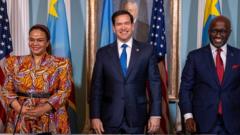In a landmark event held in Washington, the Democratic Republic of Congo (DRC) and Rwanda have officially signed a peace agreement, a step that has spurred hope for stability in the central African region plagued by decades of tumultuous conflict. The accord comes more than five months after a “declaration of principles” was established in April, yet skepticism persists given the history of failed peace treaties in this volatile area.
Key elements of the agreement focus on the need for "disengagement, disarmament and conditional integration" of armed factions operating in eastern DRC, an area where significant fighting has escalated, particularly with the M23 rebel group seizing strategic territories, including cities and airports. This ongoing violence has resulted in widespread deaths and displacement of civilians, with the DRC government appealing for international assistance as they grapple with these threats.
U.S. President Donald Trump heralded the initial agreement as a "great day for Africa" reflecting the optimism behind this potential diplomatic breakthrough. The signing of the deal by both nations’ foreign ministers at the U.S. State Department comes as the DRC sees the exchange of access to its vital mineral resources, like coltan, as trade for enhanced security guarantees from the U.S.
Despite the trumpeting of this sign of progress, Rwanda's Foreign Minister criticized a leak of the draft peace details, raising concerns over confidentiality in the negotiations. Controversies surrounding the presence of Rwandan troops—reportedly numbering around 7,000 on Congolese soil—highlight the divide, as calls for complete troop withdrawal have intensified but remain unresolved.
Questions regarding the specifics of the peace deal linger, including whether the M23 will withdraw from captured territories, clarification on Rwandan troop presence, and the practicalities surrounding the return of displaced persons from Rwanda. Observers remain uncertain if this agreement will genuinely translate into peace on the ground or end up being another in a series of unfulfilled promises.
Furthermore, the humanitarian implications of the deal, particularly concerning the reopening of rebel-held airports for aid, remain a significant point of contention as stakeholders grapple with the internal complexities and regional tensions that continue to undermine lasting stability in the area. With the DRC’s long history of conflict deeply rooted in power struggles and external influences, the international community watches keenly as the negotiations unfold, hopeful for a genuine path toward peace.
Key elements of the agreement focus on the need for "disengagement, disarmament and conditional integration" of armed factions operating in eastern DRC, an area where significant fighting has escalated, particularly with the M23 rebel group seizing strategic territories, including cities and airports. This ongoing violence has resulted in widespread deaths and displacement of civilians, with the DRC government appealing for international assistance as they grapple with these threats.
U.S. President Donald Trump heralded the initial agreement as a "great day for Africa" reflecting the optimism behind this potential diplomatic breakthrough. The signing of the deal by both nations’ foreign ministers at the U.S. State Department comes as the DRC sees the exchange of access to its vital mineral resources, like coltan, as trade for enhanced security guarantees from the U.S.
Despite the trumpeting of this sign of progress, Rwanda's Foreign Minister criticized a leak of the draft peace details, raising concerns over confidentiality in the negotiations. Controversies surrounding the presence of Rwandan troops—reportedly numbering around 7,000 on Congolese soil—highlight the divide, as calls for complete troop withdrawal have intensified but remain unresolved.
Questions regarding the specifics of the peace deal linger, including whether the M23 will withdraw from captured territories, clarification on Rwandan troop presence, and the practicalities surrounding the return of displaced persons from Rwanda. Observers remain uncertain if this agreement will genuinely translate into peace on the ground or end up being another in a series of unfulfilled promises.
Furthermore, the humanitarian implications of the deal, particularly concerning the reopening of rebel-held airports for aid, remain a significant point of contention as stakeholders grapple with the internal complexities and regional tensions that continue to undermine lasting stability in the area. With the DRC’s long history of conflict deeply rooted in power struggles and external influences, the international community watches keenly as the negotiations unfold, hopeful for a genuine path toward peace.


















